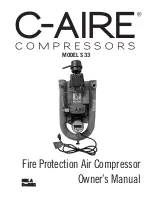
SB-509-2
19
2.3
Safety references especially for the use in
zones 1 and 2
DANGER
Risk of explosion due to hot surfaces!
The surface temperature of 140°C must not be
exceeded at any point!
DANGER
Risk of explosion due to spark formation!
Avoid ignition sources and open fire!
Use only low-sparking tools!
Mobile phones must be switched off!
DANGER
Risk of explosion due to dust and oil!
Avoid all contamination!
Clean the whole system as needed but at least
every six months.
DANGER
Risk of explosion due to the discharge of elec-
trostatic charge accumulation!
Use only devices suitable for potentially explos-
ive atmospheres and assess and list them in the
explosion protection document of the end user!
Do not operate devices near highly energetically
charged processes (e. g. mechanical separation
processes)!
Take measures against electrostatic charging of
non-metallic components, tools, auxiliaries and
clothing!
Wear, for example, antistatic clothing, use low-
sparking tools, moist cloth for claeaning, and
perform an additional earthing of conductive
parts.
In addition to the EU Explosion Protection Directive
2014/34/EU (ATEX 114) and the safety regulations in-
dicated in the standard Operating Instructions, the spe-
cific regulations EN 60079, EN 13463, EN
80079-36/-37 and the EU directive 1999/92/EC (ATEX
137) must be adhered to!
3
Application ranges
Refrigerant
• HFC refrigerants R404A, R507A, R134a
• HCFC refrigerants R22
• NH
3
(specific NH
3
design OS.A74.-EX)
Oil
• For HFC refrigerants: Polyolester oil BSE170
• For R22: Alkylbenzene oil B100, complex ester oil
B150SH
• For R717/NH
3
: KC68 (MO), SHC226E (PAO)
Use of other lubricants upon request.














































